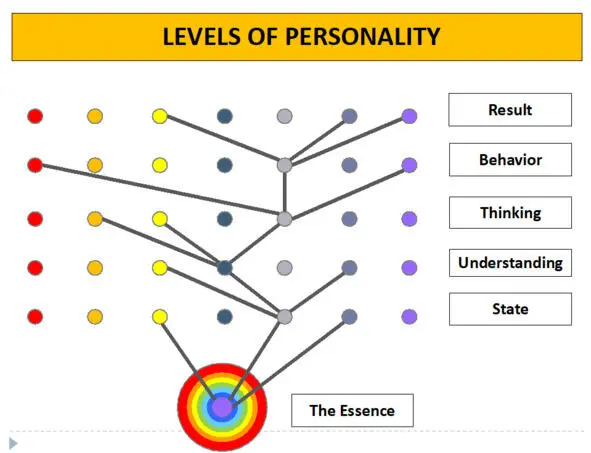So you can and should work with the emotional state itself helping not only understand what caused it but transforming it into a positive form.
Some emotional states are kept in one’s psyche for years and even decades. It was Sigmund Freud who pointed out that all events and feelings are preserved in one’s subconscious part of our memory in the present tense irrespective of how long ago something happened. Emerged once emotional states continue determining the perception of reality, thoughts and behavioral reactions of a person independently from his consciousness. Because of that a person says that he can’t do anything with himself, even though he realizes that he acts inadequately and has feelings which cannot be explained rationally. Our theoretical premise is that it is negative emotions that cause any psychic and psychosomatic disturbance.

Figure 1 shows the scheme explaining these ideas
The basis of human psychological world is his essence.
This notion is difficult to define, but this is what we really are, our essence. Carl Jung called it selfhood, you may call it your soul or your deep Ego, but we prefer the term essence. The essence predetermines main capabilities of a person is the initial point that unrolls into his potential. The essence has its layers, levels and parts, but normally is a whole, well-integrated formation. Any damage of the essence can lead to serious psychic disturbances even to psychic disorders. In such cases the essence seems to break up and its parts start fighting with each other. There is a supposition that in case of schizophrenia a person rejects himself fully, totally which is the reason of wrong perception of reality [delirium, hallucinations].
When disturbances are not too bad depressions, panic attacks, neurosis of obtrusiveness, psychosomatic diseases may occur. For example, a person may reject his Inner Child or some “bad” part of himself. He rejects this part but it comes back to him again and again and he lives in constant fight with himself. Different problems of personal identity, for instance, sexual identity also refer to essence disturbances. See some examples further.
The essence can give rise to [or maintain] a certain set of emotional states. According to circumstances these states are more or less probably switched on. A well-wishing essence will hardly produce angry and aggressive states. A depressed essence can’t produce tender, playful and joyful states.
But even if the essence is intact and undamaged the psyche can keep some negative emotional states, which then may act as self-sufficient inner causes that bring about neurotic or psychosomatic disturbances. The theory explaining the appearance of chronic negative emotional states as a result of a psychodynamic conflict will be given later. These same conflicts may damage a person’s essence, when for some reason a person revolts against himself, separates from himself, refuses from himself and even loses himself.
We draw your attention to the fact that the offered model presupposes active behavior coming from deep psyche to the outside reality, and not just reactive behavior only reflecting reality reacting to outer events.
8. Levels of an individyal and the tasks of eit
Both clients and doctors may approach treatment tasks from different premises and at different levels, which depends on theories that the doctor believes in consciously or subconsciously as well as on his aims. A personality can reveal itself ae different levels: the level of behavior, of thinking, of insight [understanding] of states and of essence. Everything starts from the deeper level of essence and gradually unrolls to the level of behavior. Behavior leads to some results according to which a person makes some conclusions. So we proceed from the model of active behavior developing from deep inside outward, and not reactive behavior when behavior is just a response to outer impact.
1. The level of behavior. The most evident task is to find such way of behavior that can resolve some conflict, reach an agreement, protect oneself, defeat one’s opponent and so on. In this case the doctor is expected to give a recommendation about how to behave in this or that situation, what to say, what to answer, what strategy to stick to, how to learn to behave properly so as to get the desirable result.
To work out the right way of behavior psychologists make use of various trainings, give detailed individual instruction, play role games, give advice and recommendations and so on. For such psychologists, behavior is nothing more but just behavior. If a person behaves himself as if he had no fear that means that he really has no fear. Such trainings can really be effective. Some people should be taught proper manners and right ways of expressing their ideas, others should be taught how to socialize and how to be self- confident and so on.
But this way of dealing with psychological problems reminds me a fable about a devil who wanted to become a saint and he implored a priest famous for his sainthood to teach him how to become a saint. Naturally the priest refused for a long time but seeing how sincerely the devil pleaded with him, he finally agreed. He said: “As you are begging so hard here is the first commandment: Whoever slaps you on your right cheek, turn to him the other also. Strictly follow this commandment!” The devil was pleased and he left. But he reappeared in the evening bruised all over. “What “s happened?” – the priest was surprised – “I have told you: Whoever slaps you on your right cheek, turn to him the other one!” “Yes, – answered the devil, – but I was slapped on the left cheek!”
The priest had to explain to the devil how and in what circumstances one should follow this commandment correctly. It turned out that in some situations one should really let be hit another time whatever part of the body was hit first. In another situation one should run away as soon as possible, in still other situation it is worth to rebuff but by peaceful means, and sometimes it is necessary to bravely defend oneself. In still other cases it is sensible not to go to an unsuitable place and not to have anything to do with bad people and in the fifth case – to evade a blow time! And so on. A detailed instruction was needed for every case; it became a whole book.
But the devil always got into a mess, as there was usually a variant of behavior that wasn’t taken into account in the instruction book, besides he didn’t always have time to take out the book, to find the needed page and to read the right advice! And there were other commandments and they also needed numerous commentaries and explanations, exceptions and variants of behavior.
Many years passed, the book became huge the priest died and the devil failed to learn how to be a saint! Why? What was the mistake? How would you answer this question? Our answer you will read a little later.
2. The level of thinking. The second way to resolve the problem is to influence the client’s thoughts. Potentially thoughts contain a whole set of possible ways of behavior. The right thoughts allow to behave correctly without working out certain ways of behavior, modifying them according to circumstances and tasks.
Thoughts are integrated in a logical system. By logic rules we can combine different thoughts, make conclusions, in doing so influence various areas of a person’s life, following logical ties between phenomena of his psychic life and different situations and ways of behavior. People are used to subordinating their behavior to logic and if a doctor could prove some idea to a client, this idea begins to transform the client’s behavior, effect his decisions and emotions. This is the basis of cognitive-behavioral therapy.
Читать дальше













